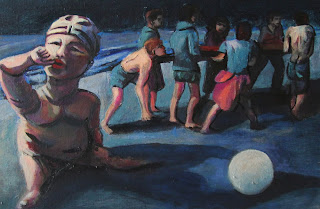Les porteurs: teenage pallbearers
In the small painting “Les Porteurs (kentan),” a group of six teenagers carry a wooden pallet with an unseen body in the dark shadows of an incoming night. They are by the sea. Directly in front of them, a child, with exotic features with a missing extremity or two, looks on, and by the child, a globe, a full moon (?), in the sand. The sun could be setting to their left, as there are streaks of shadow being projected to the right of the canvas. Or more likely, as sunsets rarely are strong enough to cast such deep shadows, there is some sort of “réverbères” to their left, throwing dramatic lighting on an enigmatic scene.
Les Porteurs (kentan)
2012 - 2017
Oil on linen
18 x 24 cm
The exotic-looking child is actually an Olmec figurine. He, like the flying Tibetan monk from the Rubin Museum, has made multiple appearances in my paintings since I ran into him at the Metropolitan Museum of Art in New York back in 2002.
His first appearance was in 2003, in a painting I painted while living Harlem, on W. 132nd Street. Over the course of painting though, he changed and morphed into a long-haired girl, with her belly split open, an old surgical wound, unable to heal because she had lost all ability to do so. That kneeling surgical intern’s job was to do her abdominal wound dressings each morning. Abdominal ascites would flow out from this wound. Behind them, a body being dressed up for the morgue, or perhaps they are in a virtual morgue. That woman is actually the child’s mother, dead from AIDS.
Harlem Studio
2003
Oil on canvas
60 x 72 inches
Nearly a decade later, in 2012, the Olmec child made a comeback here in Paris. He was there again, in the left lower corner of a large painting. This time, it is at a beach, there is a red sea, waves, and some sort of farcical parade is going on. People dressed as Roman centurions carry a sea vessel, and behind them walks Louis-Philippe, King of the French.
Louis-Philippe, roi des français
(ba mabaz magran ek agathaen moman)
2012
Oil on linen
97 x 146 cm
The teenage pall-bearers appear also in this painting. They are carrying a sort of giraffe, no doubt made during some school art project, their contribution to this strangely doomed parade for a long dead and long deposed monarch.
* * *
“Kentan” is a Wardwesân term, which in of itself, has no meaning. It is a verbal noun from the verb “kentãn.” The associated gnomic noun, “kentama,” appears in syllabary writing in the painting “Lord Yama (kentama).” One has to alter “kentan” in Wardwesân in order for it to have any real grammatical meaning. The most direct equivalence for it would be the French expression “ne plus,” no longer.





Comments
Post a Comment